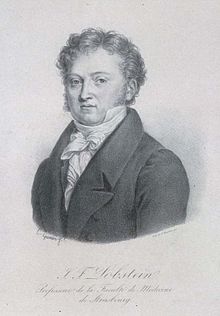
Jean Georges Chrétien Frédéric Martin Lobstein (German spelling: Johann Friedrich Georg Christian Martin Lobstein) (8 May 1777 – 7 March 1835) was a German-born, French pathologist and surgeon who was a native of Giessen. He was the nephew of noted surgeon Johann Friedrich Lobstein (1736-1784).
In 1803 he earned his doctorate at the University of Strasbourg, subsequently working as an anatomical prosector as well as an assistant to the médecin-accoucheur en chef at the Civil Hospital (Strasbourg). In 1805 he became a professor at École d'obstétrique du Rhin inférieur (School of Obstetrics of the Lower Rhine), where he ultimately served for thirty years. In 1819 he attained a professorship in pathological anatomy.
Jean Lobstein is remembered for contributions made in the field of pathological anatomy. He coined the term 'osteoporosis.'[1] He also described a disorder known today as osteogenesis imperfecta type I, which is sometimes called "Lobstein's disease". This disease is an hereditary, generalized connective tissue disorder characterized by bone fragility and a blue-gray sclerae of the eyes. In 1813 he founded an impressive pathological museum in Strasbourg, a collection that remained intact until the years following the Franco-Prussian War, when its artifacts were either dispersed or lost.
Lobstein's best written effort was an unfinished four-volume work titled "Traité d’anatomie pathologique", being based on his personal experiences as a pathologist. In its second volume he coined the word "arteriosclerosis" in a section on arterial disease.[2][3][4] In addition to his work in medicine, he was an avid archaeologist, historian and numismatist.
Associated eponym
[edit]- Lobstein's ganglion: Also known as the thoracic splanchnic ganglion; a small collection of nerve bodies on the greater thoracic splanchnic nerve.
References
[edit]- MedicineNet (article on Lobstein's Disease)
- Jean Lobstein @ Who Named It
- ^ Gerald N. Grob (2014). Aging Bones: A Short History of Osteoporosis. Johns Hopkins UP. p. 5. ISBN 9781421413181. Archived from the original on 23 July 2014.
- ^ Jean Georges Chrétien Fréderic Martin Lobstein - bibliography @ Who Named It
- ^ [1] Archived 2007-10-16 at the Wayback Machine Physiological Reviews
- ^ [2] Haimovici's vascular surgery, Volume 151 By Enrico Ascher, Henry Haimovici